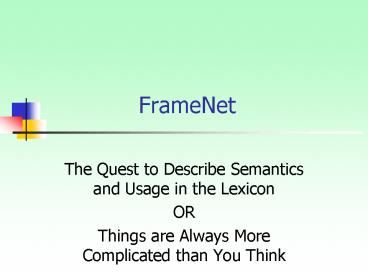FrameNet - PowerPoint PPT Presentation
1 / 14
Title: FrameNet
1
FrameNet
- The Quest to Describe Semantics and Usage in the
Lexicon - OR
- Things are Always More Complicated than You Think
2
Outline
- Whats FrameNet?
- Background
- What are Frames?
- Some exercises
- Color
- Perception
- Breaking Things
3
What is FrameNet
- Lexical semantics project, focused on words and
their contexts - Our output is a database connecting Frames, Frame
Elements, words, and semantic annotation - Useful for second-language learners and
ultimately crucial for a variety of natural
language applications
4
Theoretical underpinnings and tenets
- Frames are the best way to provide semantic
structure to the lexicon - Construction Grammar links syntax to the semantic
structure - Corpus linguistics or bust!
5
Whatsa frame?
- Essentially like a schema, scenario, or (at least
some kinds of) gestalt - Defined by the interrelations of frame Elements
(FEs) - Evoked by Lexical Units (words in a particular
sense)
6
Picnicking a simple example
- The "Oh my God!" factor greeted students Greg
Snyder, Kyle Hanigosky and Chris Pohlar as they
picnicked at various points in one of downtown
Cincinnati's most congested areas, Court Street. - FEs Picnickers, Food, Pleasant locale, etc.
- Evoked by picnic (noun and verb), i.e. picnic.v
and picnic.n.
7
(Just in case youre curious)
- "We could hear one lady literally saying, 'Oh, my
God!' as she did a double take driving by when
she was looking for a space to park, and we were
picnicking in the parking space," explained
Pohlar.
8
Exercise 1 Color
- Question What are the frame elements?
- Frame Net is data driven, so we look at the data
(i.e. real sentences) to find out
9
Resulting Definition
- A Color serves as a landmark in color-space,
either a point-like landmark (burnt sienna) or a
broader region (e.g. blue). Especially when the
Color designates a broad region in color-space,
it may be defined with a specific Type, further
specified by comparison to the color of a
Comparand, modified by a Color_qualifier, or
evaluated with a Descriptor. All color words are
generally used to specify the color of some
(physical) Entity .
10
Differentiating frames
- We ignore distinctions based on delivery context
register, dialect, attitudinals, deixis - E.g. carry vs. lug or come vs. go.
- We pay attention to the number and kinds of
entailed entities, both realized and implicit - We pay attention to the presuppositions of words
and other kinds of relationships to other
concepts.
11
Exercise 2 Perception
- How many frames do we have?
- What are the frame elements?
12
Perception sample word list
- eavesdrop.v, eye.v, detect.v, feel.v, gaze.n,
gaze.v, glance.n, glance.v, hear.v, listen.v,
look.v, observation.n, observe.v, overhear.v,
palpate.v, peek.n, peek.v, peep.v, peer.v,
perceive.v, perception.n, see.v, sense.v,
smell.v, sniff.n, sniff.v, spy.v, stare.n,
stare.v, taste.n, taste.v, view.v, watch.v
13
Breaking Things
- How many frames are there?
- What are the frame elements?
14
The End
- Michael Ellsworth,
- FrameNet lackey
- infinity_at_icsi.berkeley.edu































